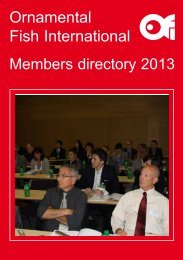Import and Export legislation - Ornamental Fish International
Import and Export legislation - Ornamental Fish International
Import and Export legislation - Ornamental Fish International
You also want an ePaper? Increase the reach of your titles
YUMPU automatically turns print PDFs into web optimized ePapers that Google loves.
<strong>Ornamental</strong> <strong>Fish</strong> <strong>International</strong><br />
(ii)<br />
- whose listing in the Annex for<br />
reasons of similarity in<br />
appearance to other species<br />
listed in Annex A or Annex B,<br />
is essential in order to ensure<br />
the effectiveness of controls<br />
on trade in specimens of<br />
such species;<br />
- species in relation to which it<br />
has been established that the<br />
introduction of live specimens<br />
into the natural habitat of the<br />
Community would constitute<br />
an ecological threat to wild<br />
species of fauna <strong>and</strong> flora<br />
indigenous to the Community.<br />
Annex C<br />
(a) the species listed in Appendix III to<br />
the Convention, other than those<br />
listed in Annexes A or B, for which<br />
the Member States have not<br />
entered a reservation;<br />
(b) the species listed in Appendix II to<br />
the Convention for which a<br />
reservation has been entered.<br />
Annex D<br />
(a) species not listed in Annexes A to<br />
C which are imported into the<br />
Community in such numbers as to<br />
warrant monitoring;<br />
(b) the species listed in Appendix III to<br />
the Convention for which a<br />
reservation has been entered.<br />
Procedures<br />
Also the procedures for imports into<br />
80<br />
Legislation<br />
the EU are not the same as for other<br />
countries in the world. An export<br />
permit is of course needed for every<br />
import into the EU. With the export<br />
permit the importer applies for an<br />
import permit from that national CITES<br />
management authority.<br />
Europe has introduced two levels of<br />
scientific committees, the national<br />
scientific committee <strong>and</strong> the scientific<br />
review group (SRG), which consists of<br />
representatives from the national<br />
scientific committees. They decide on<br />
amendments to the Annexes, but also<br />
decide on "negative opinion" regarding<br />
the import of certain species from<br />
certain locations. Every few years the<br />
negative opinions are published by the<br />
EU in a Regulation. Those species for<br />
which a negative opinion has been<br />
formulated are not allowed to be<br />
imported. All up-to-date species<br />
information, including legal status <strong>and</strong><br />
any negative opinions may be found<br />
on: http://sea.unep-wcmc.org/eu/<br />
Taxonomy/index.cfm.<br />
In an application for an import permit,<br />
the national management authority will<br />
compare the application with the<br />
annexes <strong>and</strong> with the negative<br />
opinions. If deemed necessary, the<br />
national management authority may<br />
send the application to the national<br />
scientific committee, which checks<br />
whether the import of the species will<br />
not endanger survival of the species,<br />
<strong>and</strong> whether all other criteria are met.<br />
The national scientific committee can<br />
refuse an import permit.








